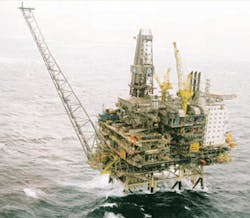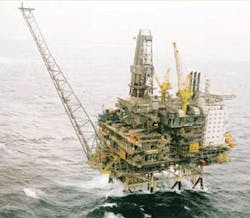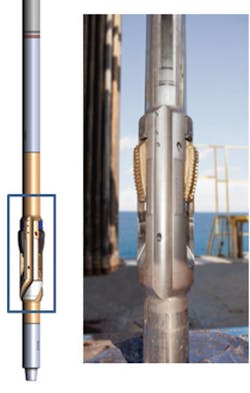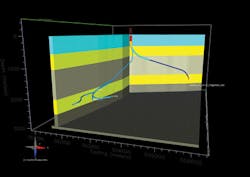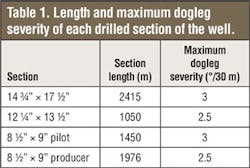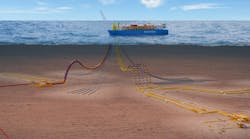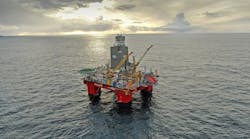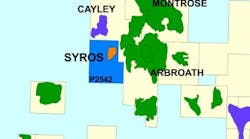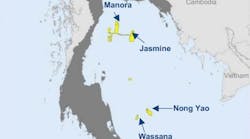Device proves capability offshore Norway
Lei Fang
Arvid Manseth
Kjell Stue
Baker Hughes
A new expandable under reamer (UR) technology has been successfully applied at a field offshore Norway. The technology was used to drill five sections of a well in the field: 14¾-in. × 17½-in., two 12¼-in. × 13½-in. sections, and two 8½-in. × 9-in. sections.
The UR proved its capability as a near bit reamer to eliminate the rathole in the same drilling run, and also proved to be a reliable main reamer for reaming long sections, while satisfying all requirements for directional control and measurement while drilling/logging while drilling (MWD/LWD) measurements.
The goal here is to present the technical features and the associated benefits of the UR technology, and describe the results of its use offshore Norway.
Under reamer
The new under reamer can be fully integrated with the company’s rotary steerable system, which enables unlimited on-demand activation and deactivation cycles. It does this by downlinking, with each cycle taking less than five minutes. The UR technology provides flexible and optimal placement of the reamer in the bottomhole assembly (BHA), and real-time feedback from downhole.
The flexibility of the placement in the BHA allows the under reamer to be used as a near-bit reamer, a main reamer, or both. When used as a near-bit reamer, the reamer can reduce the rathole length to a minimum of four meters (13 ft) in the same drilling run, eliminating the need for a dedicated rathole elimination run. The real-time feedback includes confirmation of the blade activation status. This reduces operational uncertainties for under reaming and saves rig time for a shoulder test that is otherwise required.
The technology proved its effectiveness as a reliable main reamer as well as a near-bit reamer for rathole elimination while satisfying all requirements for directional drilling and enabling MWD and LWD measurements.
Field characteristics
The field discussed here is an offshore oil field in the northern part of the North Sea. The field primarily contains oil, with minor quantities of gas. It has been in production since the early 1990s, and work is still ongoing to find ways to increase recovery. Success in drilling new producing wells is critical to maintain and extend its life.
Historically, the overburden stratigraphy at the field has been challenging for drilling. The unstable green clay and shale formation, the casing and completion programs, and equivalent circulation density (ECD) concerns associated with drilling extended- reach wells necessitate hole enlargement while drilling. The UR technology was used to address these challenges in drilling the five sections of the well noted above.
Over time, the green clay formation in the upper section has caused tight spots with high inclination well paths, and has caused swells as well. Drilling the 12¼-in. section with the presence of shale formation was frequently accompanied by difficulties in pulling the BHA out of hole after reaching total depth (TD), and running down casing subsequently. Challenging extended-reach well paths were usually designed to maximize production from the reservoir, and controlling ECD was critical for successfully drilling the reservoir sections.
Hole enlargement
Hole enlargement while drilling is a common practice used by operators to address drilling challenges, such as ECD reduction, swelling and reactive formation and tight casing tolerances, and to increase production. Concentric expandable reamers, also called under reamers, have existed for decades and are most commonly used. Traditionally, under reamers were activated by dropping a steel ball, which creates a bore restriction and develops a differential pressure to open the blades.
The single-activation ball drop tools remain activated with the blades extended whenever the flow is above a certain threshold. This limits the ability to circulate while the tool is in the casing or is being pulled out of hole. Ball drop under reamers were later developed to be able to lock the arms by dropping a second ball to either allow reaming of a specific interval of the wellbore or to allow full circulation while pulling out of hole.
In most cases, however, the second ball drop permanently deactivates the tool without the possibility of reopening it. This poses a limitation in cases where multiple intervals of a section need to be selectively reamed, or in cases where the reamer needs to be deactivated and pulled into casing prior to completion of the planned reaming (the latter could be due to reasons such as bad weather, hole problems, and/or failure of other tools in the drillstring).
In addition to limited activation and deactivation cycles, other limitations exist with the more traditional ball drop reamers. To allow the dropped balls to pass through the drillstring to the ballseat and ensure connectivity of the MWD/LWD and the rotary steerable system (RSS) packages, the ball drop under reamers are usually placed at the top of bottom hole assembly (BHA) above both MWD/LWD and RSS packages. However, this leaves the possibility of 30 to 70-m of under gauged rathole to TD, which can then present problems with running casing to TD as well as problems of breaking down the formation while cementing.
In some cases, the operators have to make a dedicated run to reduce the length of the rat hole, incurring additional rig time and associated expense, while the hole condition can deteriorate with the additional formation exposure time.
Finally, in the past, the activation and deactivation status and the health of the tools were not directly measured and monitored in real time. Instead, indirect parameters such as torque and standpipe pressure were utilized to infer the status of activation. Subsequently, a shoulder test would be required to confirm the status, incurring additional rig time and cost. The uncertainties in the status of activation pose significant risk, and in some cases result in under gauged holes that necessitate additional clean up runs.
Technology development
In 2008, an UR device was developed by a major operator in Norway and Baker Hughes, and successfully field tested in the North Sea. The reamer (Series 8 UR) was designed to open an 8½-in. pilot hole to a maximum hole size of 97⁄8-in. simultaneously while drilling.
Following the development of the Series 8 UR, the Series 12 (12¼-in. × 14¾-in. max.) and Series 14 (14½-in. × 17¾-in. max.) URs were developed in 2013 and 2014, respectively, in a joint project between an operator and the service company. These new reamers have built in the service company’s proprietary modular bus and connection, and work with the company’s RSS BHA. The application of the RSS and UR technology enables unlimited activation and deactivation of the reamers through downlinking, via either mud pulse telemetry or wired drill pipe, and each activation/deactivation takes less than five minutes.
Furthermore, the application enables flexible placement of the UR in the BHA and thus the near bit application to eliminate the rathole in the same drilling run. Historically, ball drop reamers are required to be placed at the top of BHA to avoid disruption to the BHA and to allow dropped balls to go through the BHA. This requirement resulted in rathole length as long as 70 m, which poses significant risks to the drilling and completion operations.
By placing the new under reamer directly above the steering unit in the BHA, the rathole length can be reduced to a minimum of four meters in the same drilling run, eliminating the need for a dedicated reaming up to reduce rathole length, saving significant rig time.
Finally, the integration of the under reamer to the BHA makes it possible to provide real-time data on the surface, including activation status of the reamer, position of the cutter blades, and internal hydraulic pressure status. The real-time feedback confirms the tool status, removes uncertainties that are associated with traditional under reaming applications, and saves the rig time that is otherwise required to perform a shoulder testing to confirm reamer blade activation.
The reamer body has been engineered to withstand challenging downhole dynamics, and a stabilizer is included directly below the blade section to mitigate impacts from downhole vibration. Electronics and a hydraulic system were developed to activate and deactivate the reamers through downlink commands distributed via the communication bus. Sensors are incorporated to provide measurements to monitor the status and health of the reamer, which can be transmitted to the surface real-time or saved to the memory for post-job analysis. Advanced fail-safe features were developed to ensure that the reamer can always be closed either via downlinking or other procedures to enable unrestricted pulling into a smaller size hole or casing shoe.
Case study
A well in the field offshore Norway was designed to be an oil producer. Three overburden sections were drilled, followed by three reservoir sections: two pilot sections and one horizontal producer. The UR was deployed to drill four of the six sections: 14¾-in. × 17½-in., two 12¼-in. × 13½-in. sections, one 8½-in. × 9-in. pilot, and one 8½-in. × 9-in. producer.
Field run 1
An approximately 800-m (2,624-ft) thick green clay layer is present in this section, and green clay is known to be a creeping/swelling formation. Due to this, there is a time limit of formation exposure before the section needs to be sealed off with casing. The UR was deployed to mitigate the risk of formation creeping and swelling.
The UR was placed directly above the MWD tools at approximately 33 m (108 ft) above the bit. The BHA drilled and reamed 2,415 m (7,923 ft) successfully, with all directional requirements met in both build/turn and tangent sections.
Throughout the run, UR parameters such as hole opening diameter, operation mode, and internal hydraulic pressure were transmitted to the surface through mud pulse telemetry and monitored in real-time. Due to hole losses and recurring mud pump problems encountered while drilling this section, the BHA needed to be pulled off bottom, and the under reamer was activated and deactivated multiple times through downlinking.
Field run 2
The shale formation, which is known to be unstable if drilled through with an inclination higher than 75°, is present in this section. The well path was planned to drop below 75° prior to drilling into the shale. The section had a planned TD right below the shale, inside which calcite stringers are also present, and thus the rathole length needed to be reduced to a minimum in order to successfully install the 10¾-in. casing. A near-bit reamer was included in the BHA to eliminate the rathole in the same drilling run to mitigate the risk.
The near bit and main reamers were placed 8 and 30 m (26 and 98 ft) above the bit, respectively. The near-bit gamma sensor and drilling optimization sub were placed below the near-bit reamer in this design. Engineering analyses were conducted in the pre-job planning phase to optimize the BHA design and to understand the maximum limit of the dogleg severity for building, dropping and turning for the BHA.
The section was drilled to TD successfully in one run, with all directional requirements met. The main reamer was activated at approximately 3,458 m (11,345 ft) and opened the 12¼-in. hole to 13½-in. while drilling to 4,553 m (14,937 ft) bit depth. The near-bit reamer was then activated together with the main reamer while drilling to TD at 4,621 m (15,160 ft) with reduced flow rate and RPM. Both reamers were then deactivated after reaching TD and the BHA was pulled out of hole after circulating to clean the hole. The 10¾-in. casing was installed successfully afterwards.
While drilling the last 68 m (223 ft) prior to reaching TD, three cutting elements (i.e., the drill bit, main reamer, and near-bit reamer) were active simultaneously and a low level of vibration was observed. The normal drilling practice for a dual reamer scenario is to keep the main reamer activated while drilling to TD, deactivate the main reamer, and pull up the BHA to position the near-bit reamer above the rathole. The near-bit reamer is then activated to ream while drilling to TD for the second time.
It was observed in previous operations that a high level of lateral vibration and whirl could be experienced while eliminating the rathole, and could cause severe damages to the BHA components. This was expected because the BHA above the near bit was essentially not stabilized in the opened hole. Compared to the normal drilling practices, in this case the activated main reamer acted as a stabilizer in the opened hole and suppressed lateral vibration. In addition, this approach saved multiple hours of rig time, compared to the normal drilling practice with dual reamer, by eliminating the need to pull up the BHA and drill to TD a second time. It is important to note that when LWD tools are present above the near-bit reamer, the impact of the opened hole size on the logging needs to be assessed.
Field runs 3 and 4
While drilling the two extended-reach 8½-in. × 9-in. reservoir sections, it was a concern that ECD might be too high. In addition, a 9-in. swell packer was planned to be used as part of the completions design. The UR S8 was included in the BHA to address the ECD challenge and to accommodate the 9-in. swell packer.
Extensive LWD services were employed for these two sections to enhance understanding of the reservoir, which made the BHAs extraordinarily long. For the producing 8½-in. × 9-in. section, the BHA was 88-m (288-ft) long; and to the authors’ knowledge, it was the longest drilling BHA ever deployed worldwide. In this BHA, the UR was placed 82 m (269 ft) behind the bit. The long and complex BHAs not only pose challenges for power management and signal transmission of the BHA, but also increases the likelihood of downhole tool failures.
The two sections, 1,415-m (4,642-ft) and 1,976-m (6,482-ft) long respectively, were reamed while drilling to TD successfully in one run, and the UR performed without any issues. In run 3, the well was kicked off from a cement plug that was not set after the previously drilled 8½-in. pilot hole. However, an open-hole side track had to performed due to the bad cement quality. The well was then built from 75° to 101° from 4,665 m to 5,763 m (15,305 ft to 18,907 ft) with a dogleg severity of 3°/30 m, and stayed tangent through target to TD at 6,058 mMD. In run 4, the well was kicked off from the cement plug set in the 9-in. wellbore drilled in run 3, built from 75° to 90° from 4,682 m to 4,856 m (15,360 ft to 15,931 ft), and stayed horizontal with three turns using dogleg severity ranging from 1.8°/30 m to 2.5°/30 m before reaching TD at 6,611 m (21,689 ft). During both runs, a low level of vibration and low wear on the UR blades/cutters were observed.
Conclusions
The under reamer was successfully applied to drill five sections of a well in the field located offshore Norway: 14¾-in. × 17½-in., two 12¼-in. × 13½-in. sections, and two 8½-in. × 9-in. sections. The UR proved its capability as a near-bit reamer to eliminate the rathole in the same drilling run and a reliable main reamer for reaming long sections, while satisfying all requirements for directional control and MWD/LWD measurements.
The risks associated with swelling green clay formation, unstable shale formation, and increased ECD with extended-reach wells were successfully mitigated with the service. The unique features, such as unlimited activation and deactivation through downlinking and real-time downhole feedback, were demonstrated to be valuable for reducing operational risks and saving rig time.
Summary info for the four sections was as follows:
14¾-in. × 17-in. section: a 2,415-m (7,923-ft) long section was successfully reamed while drilling, and the 16-in. casing was installed without any issue afterwards with the presence of a nearly 800-m thick swelling green clay formation.
12¼-in. × 13½-in. section: the UR Series 12 was used as both main and near-bit reamers to deliver a full-gauge hole while eliminating the rathole to eight meters (26 ft) in the same drilling run. The ability to place the UR close to the bit removed the need for a dedicated rathole elimination run, and saved the operator 24 hours of rig time.
8½-in. × 9-in. sections: two sections, 1,415 m and 1,976 m (4,642 ft and 6,482 ft) long respectively, were reamed while drilling successfully to TD in one run with ECD well controlled, and all directional requirements satisfied. In these two runs, extremely long and complex BHAs including the UR Series 8 were deployed to drill sections that had challenging well paths.
